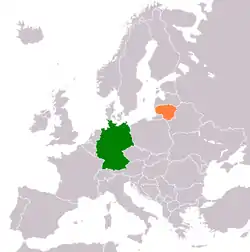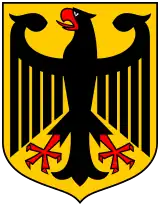Germany–Lithuania relations
Germany–Lithuania relations are diplomatic relations between Germany and Lithuania. The formal diplomatic relations existed from 1918 to 1944 and again since 1991. Both countries are members of the Council of the Baltic Sea States, the Organization for Security and Cooperation in Europe (OSCE), OECD, the Council of Europe, NATO and the European Union, as well as the Schengen area. Lithuania has also been part of the Eurozone since 2015. The relationship is described as close and reliable partnership.[1]
 | |
Germany |
Lithuania |
|---|---|

History
Medieval and post-medieval period
The name Lithuania (as Litua) first appears in written sources in 1009 in the Quedlinburg Annals in connection with the monk Bruno of Querfurt, who wanted to convert the local people to Christianity. Western powers considered the Baltic Lithuanians as the last stronghold of European paganism, potential missionary territory of the Church and expansion territory of the Livonian and Prussian knightly nobility. However, the Lithuanians were able to successfully assert themselves against the advance of the Teutonic Order in Livonia and Prussia. This self-assertion of the Lithuanians, who formed a powerful medieval state, is an important reason for the different development of the German settlements in Lithuania compared to the Baltic Germans in Estonia and Latvia: while the Baltic Germans immigrated in the course of the conquests of the Teutonic Order in the 13th and 14th centuries and formed a leading class, the Lithuanian Germans came to the country only later and formed an often rather peasant ethnic group.[2]
From 1385, the Grand Duchy of Lithuania entered into a personal union with the Kingdom of Poland. In the Battle of Grunwald (1410), the combined army defeated the Teutonic Order. The union with Poland was consolidated with the Union of Lublin in 1568. Therefore, until the end of the Polish–Lithuanian Commonwealth, there was a largely common history also in the relations with the German states. In the Peace of Oliva, Poland–Lithuania had to cede, among other things, the Duchy of Prussia to Brandenburg. The continuing internal and external decline of the state led to Lithuania (and Poland) disappearing from the map in 1795 after several partitions - undertaken by the neighbouring states of Russia, Austria and Prussia - with Lithuania being annexed by the Russian Empire. In the 19th century, despite several uprisings against the Russian regime, Lithuanian culture was increasingly threatened by Russification. Cultural contact with East Prussia (the territory of Lithuania Minor) helped preserve the Lithuanian culture, as the Lithuanian book smugglers supplied Lithuanian books printed in Latin script (which were forbidden in the Tsarist Empire at that time) across the East Prussian-Russian border at great risk.
20th century
During World War I, the German Empire, as an adversary of Russia, occupied Lithuania and some neighbouring territories in 1915 and combined them into the administrative unit of Ober Ost. Towards the end of the war, Germany wanted to recognize Lithuania as a sovereign state only if it entered into economic and military union with the Reich. On 11 December 1917, the Council of Lithuania declared the restoration of the "independent" state of Lithuania with Vilnius as its capital and with ties to the German Empire. Since Germany delayed the recognition, on 16 February 1918, the Council again proclaimed Lithuania's independence without any ties to the other states, thus forming the Republic of Lithuania. Subsequently, Lithuanians were able to defend their state during the Lithuanian Wars of Independence. In 1923 Lithuania annexed the Memelland, i.e. the part of East Prussia north of the Memel River, formerly part of the German Empire, with the port city of Memel (today Klaipėda), which had been administered by the League of Nations since the end of the War. In 1924, this annexation was recognized by the previous protecting powers. Apart from the problem of the Memelland, German–Lithuanian relations in the interwar period developed quite positively to some extent, the two states being bound together by their dislike of Poland, to which both had territorial claims.[3]
After the Nazi takeover in March 1933, tensions began to rise again, reaching a climax in February 1934 when the Lithuanian government arrested dozens of pro-Nazi activists. Following the 1939 German ultimatum, Lithuania had to cede the Memelland back to Germany. In the Hitler-Stalin Pact, Lithuania had initially been assigned to the German sphere of influence. After the outbreak of World War II, however, there was a revision of this treaty by the German–Soviet Boundary and Friendship Treaty with a change in the spheres of influence. Germany received parts of eastern Poland, while Lithuania was awarded to the Soviet Union. On 15 June 1940, the Red Army invaded and occupied Lithuania. As late as 1941, many Lithuanian Germans were resettled in the German sphere of influence. After the Operation Barbarossa, from 1941 to 1945, Lithuania was occupied by the Wehrmacht and belonged to the Reichskommissariat Ostland. During this period, Germans and Lithuanian collaborators committed crimes against humanity against opposition members and minorities. Lithuanian Jews fell victim to the Holocaust, and 95% of them didn't survive the war. In Lithuania, attempts were made to implement the so-called Kegelbahn project, i.e. the targeted settlement of certain conquered territories with German resettlers. From 1944 on, most of the Germans fled from the reapproaching Red Army or were expelled soon after. Thousands of Lithuanians fled with the Germans to the West. For the exiled Lithuanians who settled in West Germany, the Lithuanian grammar school in Hüttenfeld in southern Hesse formed a cultural preservation center. Expelled Lithuanian-Germans united in 1951 in the Landsmannschaft der Deutschen aus Litauen (Association of Germans from Lithuania).[3]
Following the Soviet occupation of Lithuania, German–Lithuanian contacts were only possible to a very limited extent during the Cold War. Lithuania restored its independence on 11 March 1990. Germany recognized the independence of Lithuania and the other two Baltic States on 27 August 1991. In the following period, Germany's policy towards Lithuania oscillated between the willingness and obligation to integrate the Baltic States into the European structures and the fear of thereby angering Russia or disrupting its rapprochement with Europe.[4] At times, Germany was even considered the main opposing voice among the Western powers with regard to NATO accession.[5]
21st century
In 2004, Lithuania joined NATO and the European Union. This marked a new relationship between Germany and Lithuania, especially within the European structures. Today, German–Lithuanian relations are intensive and friendly and continue to develop both bilaterally and multilaterally within the framework of the aforementioned organizations.
Following the Russian invasion of Crimea in 2014, the NATO Enhanced Forward Presence was established in the Baltic States, with Germany assuming the responsibility to lead the multinational battle group in Lithuania.[6] The security situation in Europe further deteriorated after the 2022 Russian invasion of Ukraine. The Baltic States requested their NATO allies to increase the military presence in the region.[7] In 2023, the military cooperation between the states reached a new level when Germany agreed to deploy a brigade in Lithuania on a permanent basis.[8]
Economic exchange
For Lithuania, Germany is an important trade and investment partner. According to the United Nations Comtrade database on international trade, in 2022, Lithuania exported goods to Germany for over 3.6 billion euros, while Germany exported goods to Lithuania for over 5.5 billion euros. Both countries trade mainly industrial goods.[9]
Migration
In 2021, over 54,000 Lithuanian citizens lived in Germany, making Germany one of the most important destination for Lithuanian immigrants within the EU.[10] Historically, a large Baltic German minority lived in Lithuania, most of which was expelled after the Soviet annexation. According to the 2021 census, just under 2000 Germans still lived in Lithuania.[11]
References
- "30 Years of German-Lithuanian Relations – A Reliable Partnership". kas.de. 15 September 2021. Retrieved 25 November 2022.
- Zentrum gegen Vertreibungen (11 January 2012). "Die Deutsch-Balten" (in German). Archived from the original on 11 January 2012. Retrieved 25 November 2022.
- "Die deutsch-litauischen Beziehungen im 20. Jahrhundert". www.litauen.info (in German). 4 March 2009. Retrieved 25 November 2022.
- Dauchert, Helge (15 December 2008). "Deutschlands Baltikumpolitik". doi:10.18452/7973.
{{cite journal}}: Cite journal requires|journal=(help) - FAZ 26th May 2001 „Litauen auf dem Weg in die Nato?“ / Lucius, Robert
- Strickland, John (10 October 2017). "U.S. Army-led NATO Battle Group on deterrence mission in Poland". www.army.mil. Archived from the original on 27 September 2021. Retrieved 27 September 2021.
- "Baltic States Are Pushing NATO for More Than Just a Tripwire Against Russia". Foreign Policy. 19 May 2022. Retrieved 28 July 2023.
- "Germany ready to put 4,000 soldiers permanently in Lithuania". Politico. 26 June 2022. Retrieved 28 July 2023.
- "Lithuania Exports to Germany". Statistisches Bundesamt. Retrieved 29 June 2023.
- "Litauen - litauische Staatsbürger in der EU". Statista (in German). Retrieved 25 November 2022.
- "Gyventojų ir būstų surašymai - Oficialiosios statistikos portalas". osp.stat.gov.lt. Retrieved 25 November 2022.
- "Deutsche Vertretungen in Litauen". Auswärtiges Amt (in German). Retrieved 25 November 2022.
- "Vertretungen Litauens in Deutschland". Auswärtiges Amt (in German). Retrieved 25 November 2022.
